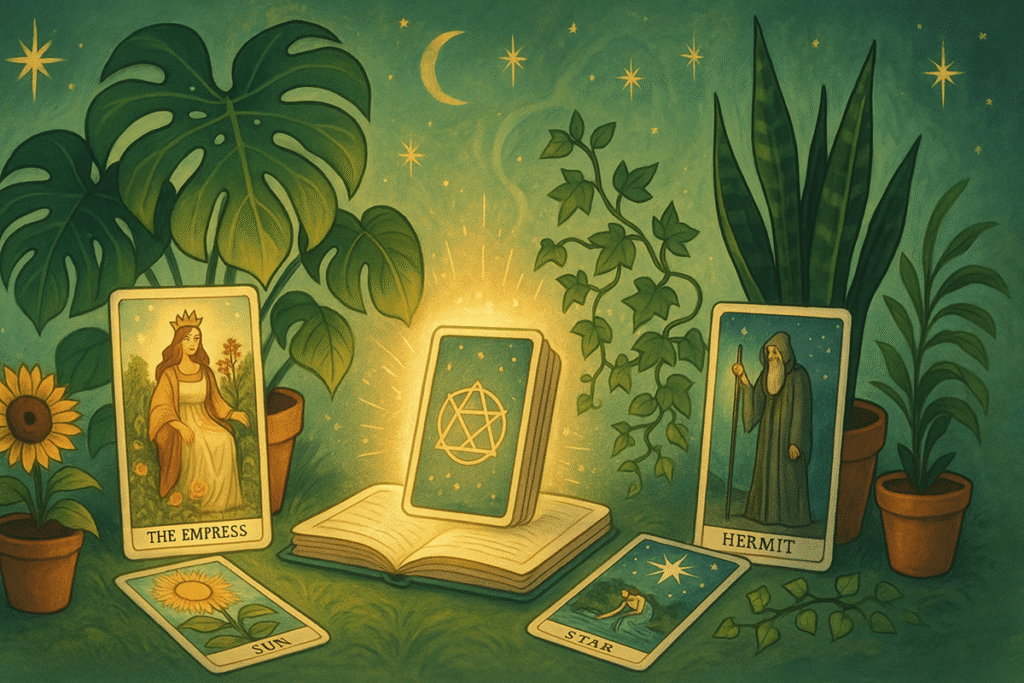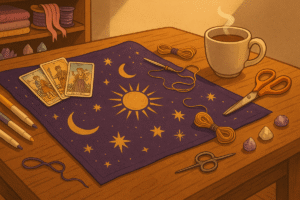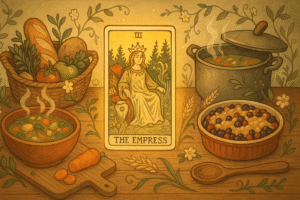Table of Contents
There’s something almost magical about the way sunlight filters through green leaves in the morning, isn’t there? I’ve been thinking lately about how both tarot cards and houseplants serve as gentle teachers in our daily lives. Perhaps that’s why combining these two practices feels so natural to me now.
The idea of creating a “tarot garden” in your living space invites us to explore how the symbolic energy of tarot cards might resonate with the living presence of plants. This isn’t about assigning rigid meanings or making predictions. Instead, it’s an invitation to reflect on the qualities both tarot and plants can inspire within us.
Why Pair Tarot Cards with Houseplants
When I first started exploring this concept, I wondered what these two seemingly different practices might have in common. Both tarot and plant care require patience, attention, and a willingness to observe subtle changes over time. They both invite us to slow down and notice what’s happening in the present moment.
Your houseplants grow and change just as you do. The tarot cards you draw often reflect themes and questions that are alive in your current life experience. Pairing them creates opportunities for deeper contemplation about growth, cycles, and the wisdom that comes from simply paying attention.
There’s also something grounding about having living plants near your tarot practice space. They remind us that growth happens gradually, through consistent care and attention rather than dramatic overnight transformations. This perspective can be particularly helpful when working with tarot as a tool for personal reflection.
The Empress and the Monstera Deliciosa
The Empress card often speaks to themes of abundance, nurturing, and creative growth. When I look at a thriving Monstera with its broad, fenestrated leaves, I can’t help but think of how both represent different aspects of generous, life-giving energy.
Perhaps what draws me to this pairing is how both the Empress and the Monstera seem to embody a kind of patient abundance. The Monstera doesn’t rush its growth; those distinctive splits in mature leaves develop slowly, as the plant reaches a certain size and maturity. Similarly, the Empress energy suggests that true abundance comes from steady nurturing rather than forced outcomes.
If you have a Monstera in your space, you might reflect on questions like: What in my life is ready to unfold naturally? Where can I offer more nurturing support to my own growth? The plant’s climbing nature might also invite contemplation about what you’re reaching toward in your own development.
I find myself wondering if the holes in mature Monstera leaves represent a kind of openness, a willingness to let light pass through rather than blocking it entirely. There’s something beautiful about that metaphor for how we might approach our own growth.
The Hermit and the Snake Plant
The solitary, upright stance of a Snake Plant feels like a perfect companion to The Hermit card’s energy of introspection and inner wisdom. Both seem to thrive in conditions that might challenge other plants or overwhelm other archetypes.
Snake Plants are remarkably self-sufficient, requiring minimal water and tolerating low light conditions. This resilience reminds me of The Hermit’s journey inward, finding illumination through solitude rather than external stimulation. There’s something almost meditative about their simple, architectural form.
When I sit with this pairing, questions arise about self-reliance and inner resources. What wisdom have I gained through quiet reflection? How can I better trust my own inner guidance? The Snake Plant’s ability to purify air even adds another layer to consider about what we might be clearing or purifying in our own lives.
The plant’s vertical growth pattern suggests reaching upward while staying firmly rooted. Perhaps this reflects the hermit’s ability to seek higher understanding while remaining grounded in practical wisdom. Sometimes I think the most profound insights come not from complex external sources, but from simple, sustained attention to what’s already within us.
The Sun and the Sunflower Plant
Pairing The Sun card with an actual sunflower feels almost too obvious, but there’s real wisdom in obvious connections sometimes. Both represent themes of vitality, joy, and following what brings life and energy.
Growing sunflowers indoors requires commitment to providing adequate light, just as maintaining the sunny disposition of The Sun card requires conscious attention to what nourishes our spirits. I’ve noticed that both sunflowers and “sunny” moods seem to be contagious in the best possible way.
What fascinates me about sunflowers is their heliotropism when young, the way they literally turn to follow the sun across the sky. This behavior invites reflection about what we orient ourselves toward in our daily lives. Are we turning toward sources of genuine nourishment and growth, or getting stuck facing directions that no longer serve us?
The mature sunflower eventually stops following the sun and faces east, greeting each new dawn. There’s something profound about this shift from seeking to radiating. Perhaps this represents a stage of development where we become sources of warmth and light for others rather than constantly seeking external validation.
The Star and the Pothos
The trailing, star-like vines of a Pothos seem to echo The Star card’s themes of hope, inspiration, and gentle guidance. Both offer their gifts generously, the Pothos through its easy propagation and the Star through its message of renewal after difficult times.
I particularly appreciate how forgiving Pothos plants are. Even when neglected, they often bounce back with proper care, much like how hope can resurface even after periods of darkness or doubt. The plant’s ability to grow in water or soil might represent adaptability and finding ways to thrive in various circumstances.
The way Pothos vines reach and spread reminds me of how inspiration tends to flow naturally when we’re receptive to it. You can’t force a Pothos to grow faster, but with consistent care and the right conditions, it will flourish beyond what you might expect. Similarly, the Star’s energy suggests trusting in natural processes of healing and renewal.
When Pothos leaves develop those beautiful white and green variegations, I think about how light and shadow can create something more beautiful together than either would alone. This might invite reflection on how our challenging experiences contribute to the overall pattern of our lives.
The Fool and the String of Pearls
The delicate, cascading nature of String of Pearls somehow captures The Fool’s energy of innocent adventure and trust in the unknown journey ahead. Both seem to embody a kind of joyful vulnerability, willing to extend themselves into new territory.
String of Pearls grows in the most charming way, sending out long trails of pearl-like leaves that seem to defy gravity. There’s something wonderfully foolish about this plant’s growing pattern, reaching out into space with apparent confidence that support will be found.
I think about how The Fool steps off the cliff in many traditional tarot illustrations, trusting that the path will appear. String of Pearls does something similar, extending beyond secure ground and somehow thriving in that extension. This pairing might invite questions about where in life you’re being called to take a leap of faith.
The succulent nature of these plants reminds us that even adventurous spirits need proper resources and care. Perhaps this reflects the wisdom of preparing for journeys while remaining open to unexpected discoveries along the way.
Creating Your Own Tarot Garden
Building your own collection of paired plants and cards doesn’t need to happen all at once. I’ve found that starting with just one or two meaningful combinations allows for deeper exploration of the connections that resonate most strongly with you.
Consider which tarot cards you find yourself drawn to repeatedly, or which ones challenge you in helpful ways. Then think about plants that might reflect similar energies or offer complementary qualities. The goal isn’t to create perfect symbolic matches, but to cultivate opportunities for reflection and mindful attention.
Your living space and plant care capabilities should definitely influence your choices. There’s no point in selecting a high-maintenance plant to represent a card about balance if caring for it will create stress rather than contemplative joy.
I like to place paired plants and cards where I’ll encounter them regularly, creating natural moments for brief reflection throughout the day. Sometimes I’ll spend just a few minutes watering a plant while contemplating its paired card’s themes. Other times, I’ll draw a card and then check on its plant companion, noticing what both might be teaching me about patience, growth, or attention.
Seasonal Reflections and Plant Care
The changing needs of houseplants throughout the year offer beautiful opportunities to explore how tarot themes might shift with seasons and circumstances. A plant that thrives in summer might require more careful attention in winter, just as certain aspects of our personal growth may need different approaches at different times.
I’ve noticed that my relationship with both plants and tarot cards deepens through consistent, gentle attention rather than intense bursts of focus. Maybe that’s one of the most important lessons of the tarot garden: growth and insight both flourish with steady, caring presence rather than dramatic interventions.
The practice of pairing tarot and houseplants ultimately invites us to slow down and notice the subtle wisdom available in everyday moments. Whether you’re misting a prayer plant or contemplating the lessons of The Hermit, both practices cultivate the kind of mindful attention that enriches daily life.
Your tarot garden will be uniquely yours, reflecting your personal connections to both symbolic meanings and living plants. Trust your instincts about what combinations feel meaningful, and remember that the most important aspect is creating space for gentle reflection and growth.
Frequently Asked Questions
Do I need to physically place my tarot cards next to the plants?
Not necessarily. The pairing is more about creating a mental and symbolic connection than a physical arrangement. You might keep a card near its paired plant as a visual reminder, display them together on a shelf, or simply think about the connection when you water your plants or work with your tarot deck. What matters most is how the pairing helps you reflect on themes of growth and patience in your own life.
Can I pair any tarot card with any plant I already own?
Absolutely. The pairings suggested in this article are starting points for reflection, not rigid rules. If you already have plants you love, consider what qualities they demonstrate and which tarot cards resonate with those themes. A struggling plant might pair meaningfully with The Tower or Five of Pentacles as you nurture it back to health. Trust your own intuitive connections over prescribed meanings.
How often should I incorporate tarot reflection into my plant care routine?
There’s no set schedule that works for everyone. Some people enjoy drawing a card while watering their plants weekly, while others prefer monthly check-ins when repotting or fertilizing. You might also pull a card only when a plant shows significant change, like new growth or dropping leaves. The practice should feel natural and sustainable rather than like another obligation on your to-do list.







